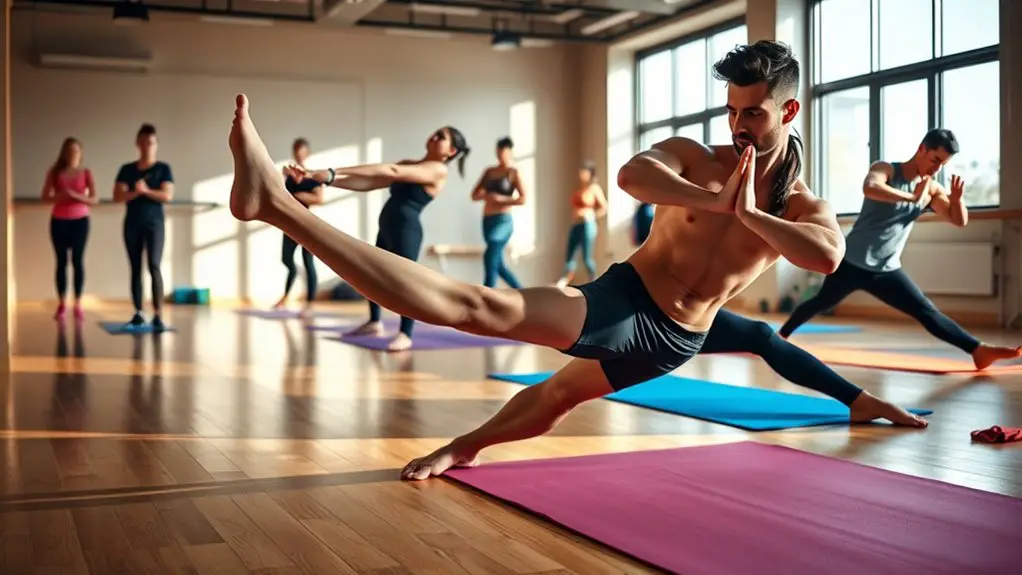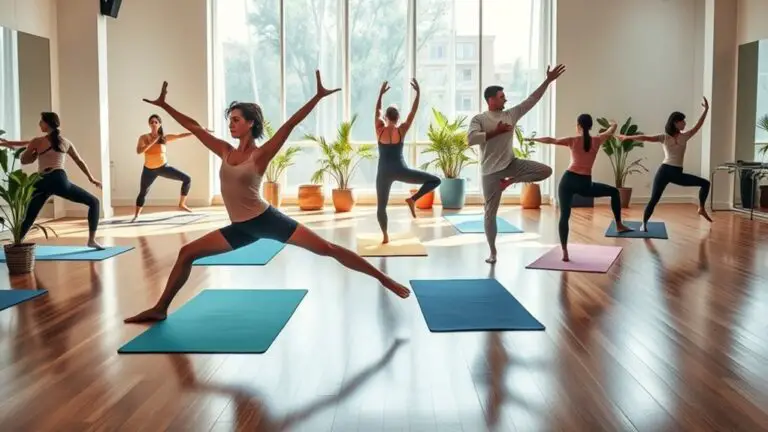The Best Stretches to Do Before and After the Gym

Before hitting the gym, you should focus on dynamic stretches like leg swings and walking lunges to prepare your muscles for action. After your workout, static stretches such as hamstring and quad stretches will aid recovery and improve flexibility. Don’t forget to engage your core and include upper and lower body stretches to enhance performance. Incorporating these practices can considerably reduce injury risk. Keep going to discover more effective stretches for your routine!
Importance of Stretching Before and After Workouts

When you think about your workout routine, don’t underestimate the importance of stretching both before and after. It’s not just about flexibility; the benefits explained go far beyond that. Stretching helps increase blood flow to your muscles, reducing the risk of injury during your workouts. Many people have common misconceptions about stretching, believing it’s only for improving flexibility or that it doesn’t matter if you skip it. However, stretching plays an essential role in preparing your body for exercise and aiding recovery afterward. By incorporating stretches into your routine, you can enhance your overall performance, alleviate muscle tightness, and promote a greater range of motion. This simple practice can help you feel better during your workouts and support your long-term fitness goals. So, remember to take the time to stretch properly; your body will thank you for it.
Dynamic Stretches to Do Before the Gym
To get your body ready for a workout, incorporating dynamic stretches is a great way to kick things off. These dynamic warm ups help increase your heart rate and improve flexibility, making them essential for a safe workout. Start with leg swings, moving your legs forward and backward to loosen up your hips. Next, try walking lunges, which engage multiple muscle groups while enhancing mobility. Arm circles are also effective; they warm up your shoulders and upper body.
Incorporating mobility drills such as high knees and butt kicks can further elevate your heart rate and prepare your muscles for action. Remember, the goal is to gradually elevate your body temperature and get your joints moving. Spend about 5 to 10 minutes on these dynamic stretches, and you’ll set yourself up for a successful workout while minimizing the risk of injury.
Static Stretches for Post-Workout Recovery

After you’ve finished your workout, incorporating static stretches is essential for aiding recovery and improving flexibility. These stretches can help reduce muscle tension and soreness, contributing to a more effective post workout recovery. Here are some key static stretch benefits you should consider:
- Improved Flexibility: Regular static stretching enhances your range of motion, making future workouts easier.
- Reduced Muscle Soreness: Stretching post-workout can alleviate discomfort, allowing you to bounce back faster.
- Enhanced Relaxation: Static stretches promote relaxation, helping your body shift from workout mode to rest.
To perform static stretches safely, hold each position for 15-30 seconds without bouncing, focusing on deep breathing. Prioritize muscle groups you’ve worked, ensuring a balanced approach to recovery. By integrating these stretches into your routine, you’ll set yourself up for a safer and more effective fitness journey.
Upper Body Stretches to Enhance Performance
Upper body stretches are essential for enhancing your performance and preventing injuries during workouts. Focusing on shoulder mobility is key, as it allows for better range of motion and reduces strain on your joints. One effective stretch is the arm circles. Stand with your feet shoulder-width apart, extend your arms to the sides, and make small circles. Gradually increase the size of the circles for about 30 seconds, then switch directions. This helps warm up your shoulders and prepares them for more strenuous activities.
Another great stretch is the doorway stretch, which targets your chest and shoulders. Simply stand in a doorway, place your arms on the frame, and lean forward gently. Hold this position for 20 to 30 seconds. Incorporating these stretches into your routine not only enhances performance but also promotes flexibility and safety, allowing you to enjoy your workouts without the fear of injury.
Lower Body Stretches for Flexibility and Strength

When it comes to lower body stretches, focusing on your hamstrings and quadriceps can really enhance your flexibility and strength. You’ll find that incorporating specific techniques for these muscle groups can prevent injuries and improve your overall performance. Let’s explore some effective stretches you can add to your routine.
Hamstring Stretch Techniques
Hamstring stretches are essential for enhancing flexibility and strength in your lower body, especially if you’re preparing for a workout or recovering afterward. Incorporating dynamic hamstring stretches can help prevent injuries and improve your performance. Here are a few techniques you can try:
- Standing Hamstring Stretch: While standing, extend one leg forward and reach for your toes, keeping your back straight. Hold for 15-30 seconds.
- Seated Hamstring Stretch: Sit with one leg extended and the other bent. Reach toward your toes of the extended leg, holding for 15-30 seconds.
- Dynamic Leg Swings: Stand and swing one leg forward and backward, keeping your core engaged to improve hamstring flexibility.
These techniques will keep your hamstrings healthy and ready for action!
Quadriceps Flexibility Exercises
Maintaining flexibility in your quadriceps is just as important as stretching your hamstrings. Tight quads can lead to discomfort and injuries, especially during workouts. Start with dynamic quad stretches like leg swings or walking lunges. These warm-up techniques help increase blood flow and prepare your muscles for activity.
For static stretching, consider using quadriceps stretch techniques such as the standing quad stretch, where you pull your heel toward your glutes while standing on one leg. Hold for 20-30 seconds, ensuring you keep your knees close together for best results. Always listen to your body; if you feel pain, ease off the stretch. Incorporating these exercises into your routine will enhance your flexibility and strength, promoting safer workouts.
Core Stretches to Improve Stability
Core stability is essential for overall strength and balance in your workouts. By incorporating effective core stretching techniques, you can enhance your stability and performance. Let’s explore how to seamlessly integrate these stretches into your routine for maximum benefit.
Importance of Core Stability
Stability is essential for overall athletic performance and injury prevention, and it largely hinges on the strength of your core. By focusing on core engagement, you’ll enhance your balance and coordination, which are vital for any physical activity. Incorporating stability exercises into your routine can help you build a solid foundation. Here are three benefits of improving core stability:
- Injury Prevention: A strong core supports your spine and reduces the risk of injuries.
- Enhanced Performance: Stability allows for better control during workouts, leading to improved results.
- Improved Posture: Core strength aids in maintaining proper alignment, reducing strain on your muscles and joints.
Prioritizing core stability helps you stay safe while maximizing your workouts.
Effective Core Stretching Techniques
Incorporating effective stretches into your routine can greatly enhance your core stability. Focusing on core activation through specific stretches helps prepare your muscles for stability exercises, reducing injury risk. Here are a few stretches to take into account:
| Stretch Name | Benefits |
|---|---|
| Cat-Cow Stretch | Improves flexibility and alignment |
| Plank Variations | Engages core and builds strength |
| Seated Forward Bend | Enhances lower back flexibility |
These techniques not only increase flexibility but also strengthen your core, making them perfect for warming up or cooling down. Remember to maintain proper form and breathe deeply while performing these stretches to maximize benefits and guarantee safety. Start integrating these core stretches into your routine for better overall stability!
Incorporating Stretches Into Routine
To enhance your workout routine, adding specific stretches can make a significant difference in your core strength and overall stability. Focusing on timing stretches and maintaining routine consistency will help you reap the benefits safely. Here are three effective core stretches to include:
- Cat-Cow Stretch: Promotes flexibility and spinal alignment.
- Plank to Downward Dog: Strengthens the core while improving shoulder stability.
- Seated Forward Bend: Enhances flexibility in your lower back and hamstrings.
Incorporate these stretches before and after your workouts, ensuring you’re giving your muscles the attention they need. By consistently timing your stretches, you’ll not only improve your performance but also reduce the risk of injury, keeping your fitness journey safe and effective.
Stretches for Injury Prevention
Five effective stretches can greatly reduce your risk of injury during workouts. Incorporating these stretches into your routine promotes injury prevention and guarantees safe stretching practices. Start with the hamstring stretch; it helps prevent strains in your legs. Next, try the quad stretch to keep your thigh muscles flexible. Don’t forget the shoulder stretch, which can alleviate tightness and improve your range of motion. A gentle hip flexor stretch is essential for anyone who sits for long periods, as it opens up the hips and reduces the chance of injury. Finally, the calf stretch prepares your lower legs for those high-impact exercises. Always hold each stretch for at least 15-30 seconds, and remember to breathe deeply throughout. By prioritizing these stretches, you’re not just warming up your body; you’re actively protecting yourself from potential injuries during your workouts. Stay safe and enjoy your fitness journey!
How to Incorporate Stretching Into Your Routine
While you might think of stretching as merely an addition to your workout, integrating it into your routine can enhance your overall performance and flexibility. To reap the flexibility benefits, aim for a consistent stretching frequency. Here are some tips to help you incorporate stretching safely:
- Warm-up First: Always start with a light warm-up to increase blood flow before stretching.
- Set a Schedule: Dedicate specific times for stretching—before workouts, after workouts, or even on rest days.
- Listen to Your Body: Pay attention to how your body feels. If something doesn’t feel right, adjust your stretches accordingly. Additionally, remember that static stretches are ideal for warming up before exercise.
Frequently Asked Questions
How Long Should I Hold Each Stretch?
When it comes to how long you should hold each stretch, it varies. For dynamic stretches, you typically want to keep the movements fluid and continuous, lasting about 30 seconds to a minute. For static stretches, holding each position for 15 to 30 seconds is generally safe and effective, ensuring you don’t push too hard. Always listen to your body, and if it feels uncomfortable, it’s best to ease off to prevent injury.
Can Stretching Help With Muscle Soreness?
Yes, stretching can definitely help with muscle soreness. It promotes muscle recovery by increasing blood flow and flexibility, which aids in reducing stiffness. When you incorporate stretching into your routine, you’re also contributing to soreness prevention, helping your muscles adapt better to physical activity. Just remember, it’s important to stretch safely—don’t push too hard, and always listen to your body. That way, you’ll reap the benefits without risking injury.
Is It Safe to Stretch With an Injury?
Stretching with an injury can be like walking on a tightrope—one wrong move and you might fall. While gentle stretching techniques can help maintain flexibility, it’s essential to be cautious. Always consult a healthcare professional first to guarantee you’re not exacerbating the injury. Remember, proper injury prevention is key. Listen to your body; if something feels off, it’s best to stop and seek guidance before resuming any stretching routine.
Should I Stretch if I’m in a Rush?
If you’re in a rush, it’s still important to prioritize your safety. You can opt for time efficient stretching or quick warm-ups that target major muscle groups. Focus on dynamic stretches to prepare your body without taking much time. Even a few minutes can improve your performance and reduce injury risk. Just remember, if you’re short on time, don’t skip stretching entirely—adapt your routine to fit your schedule while staying safe.
What Are the Best Stretches for Beginners?
If you’re a beginner, focus on simple stretches like the hamstring stretch, quad stretch, and shoulder stretch. These beginner techniques help improve flexibility and prevent injury. Avoid common mistakes like bouncing during stretches or holding your breath—smooth, steady movements are key. Make sure you warm up a bit beforehand to prepare your muscles. Remember, safety is essential, so listen to your body and never push yourself too hard!





